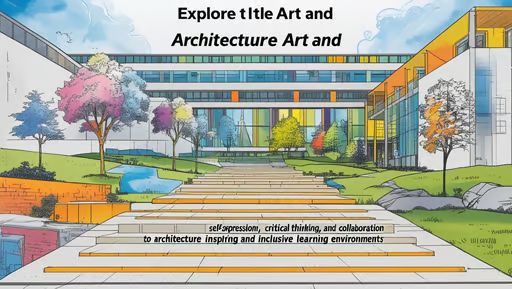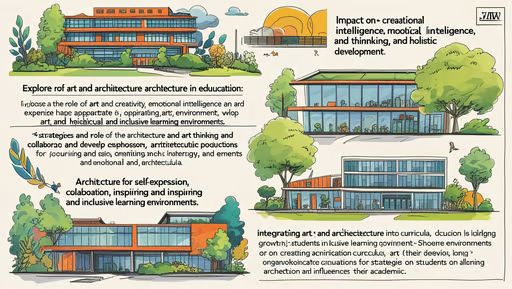The Role of Art and Architecture in Education, Art and architecture have long been integral to human expression and cultural development. Beyond their aesthetic and functional value, they play a significant role in education, fostering creativity, critical thinking, and emotional intelligence. In an era where standardized testing and STEM (Science, Technology, Engineering, and Mathematics) subjects often dominate educational priorities, the inclusion of art and architecture in curricula is essential for nurturing well-rounded individuals. This article explores the multifaceted role of art and architecture in education, highlighting their impact on cognitive, emotional, and social development.
Art in Education: A Gateway to Creativity and Self-Expression
Art education encompasses a wide range of disciplines, including visual arts, music, theater, and dance. It provides students with a unique platform for self-expression, allowing them to explore their emotions, ideas, and identities. Through art, students learn to communicate in ways that transcend language, fostering a deeper understanding of themselves and others.
1. Enhancing Cognitive Skills
Art education stimulates cognitive development by encouraging students to think critically and solve problems creatively. When students engage in artistic activities, they learn to analyze, interpret, and make decisions. For example, painting or sculpting requires planning, experimentation, and adaptation, which enhance problem-solving skills and spatial reasoning.
Moreover, art encourages divergent thinking—the ability to generate multiple solutions to a problem. This skill is invaluable in all areas of life, from academics to professional careers. Studies have shown that students who participate in art programs often perform better in other subjects, as art fosters a mindset of exploration and innovation.
2. Fostering Emotional Intelligence
Art provides a safe space for students to express their emotions and process complex feelings. Whether through painting, music, or drama, students can channel their experiences into creative outlets, promoting emotional well-being and resilience. This is particularly important in today’s fast-paced and often stressful world, where mental health issues among young people are on the rise.
Additionally, art education cultivates empathy by exposing students to diverse perspectives and cultures. Through studying and creating art, students gain insight into the human experience, fostering compassion and understanding.
3. Building Confidence and Collaboration
Participating in art projects helps students build confidence in their abilities. Whether it’s performing in a play, showcasing a painting, or playing a musical instrument, students learn to take pride in their work and overcome stage fright. This sense of accomplishment translates into other areas of their lives, boosting self-esteem and motivation.
Art also promotes collaboration and teamwork. Group projects, such as theater productions or mural paintings, require students to communicate, compromise, and work together toward a common goal. These experiences teach valuable social skills that are essential for success in both personal and professional relationships.

Architecture in Education: Designing Spaces for Learning and Inspiration
Architecture, often overlooked in educational discussions, plays a crucial role in shaping the learning environment. The design of schools and classrooms can significantly impact students’ engagement, well-being, and academic performance. Thoughtfully designed educational spaces inspire creativity, foster collaboration, and promote a sense of belonging.
1. Creating Inspiring Learning Environments
The physical environment of a school has a profound effect on students’ attitudes toward learning. Bright, open spaces with ample natural light and vibrant colors can stimulate creativity and enthusiasm. Conversely, dull, cramped classrooms can hinder concentration and motivation.
Architectural design can also reflect educational philosophies. For example, schools that emphasize collaborative learning often feature flexible, multipurpose spaces that can be easily reconfigured for group activities. Similarly, schools that prioritize sustainability incorporate eco-friendly materials and energy-efficient systems, teaching students the importance of environmental stewardship.
2. Promoting Inclusivity and Accessibility
Inclusive architecture ensures that educational spaces are accessible to all students, regardless of their physical abilities. Features such as ramps, elevators, and sensory-friendly classrooms create an environment where every student feels welcome and supported. This not only benefits students with disabilities but also fosters a culture of inclusivity and respect.
Moreover, architecture can address cultural diversity by incorporating design elements that reflect the community’s heritage and values. For example, a school in a multicultural neighborhood might feature artwork and architectural motifs from different cultures, celebrating diversity and promoting unity.
3. Encouraging Interaction and Community Building
Well-designed schools encourage interaction and community building among students, teachers, and parents. Common areas, such as courtyards, libraries, and cafeterias, provide spaces for socialization and collaboration. These areas foster a sense of community and belonging, which is essential for students’ emotional and social development.
Additionally, schools can serve as community hubs, offering facilities for public events, workshops, and recreational activities. This strengthens the connection between the school and the broader community, creating a supportive network for students and their families.
Integrating Art and Architecture into Education
To fully harness the potential of art and architecture in education, schools must adopt a holistic approach that integrates these disciplines into the curriculum and learning environment. Here are some strategies for achieving this integration:
1. Interdisciplinary Learning
Art and architecture can be integrated into other subjects to create a more engaging and meaningful learning experience. For example, history lessons can include the study of art movements and architectural styles, while science classes can explore the physics of sound in music or the structural principles of buildings. This interdisciplinary approach helps students make connections between different fields of knowledge, enhancing their understanding and retention.
2. Hands-On Projects
Hands-on art and architecture projects allow students to apply their knowledge and skills in practical ways. For instance, students can design and build models of sustainable homes, create murals that reflect social issues, or compose music inspired by historical events. These projects encourage creativity, critical thinking, and collaboration, while also providing a sense of accomplishment.
3. Exposure to Art and Architecture
Schools should provide opportunities for students to experience art and architecture outside the classroom. Field trips to museums, galleries, and architectural landmarks expose students to diverse artistic styles and cultural heritage. Guest lectures by artists, architects, and designers can also inspire students and provide insights into creative careers.
4. Professional Development for Educators
Teachers play a key role in integrating art and architecture into education. Providing professional development opportunities for educators can help them incorporate these disciplines into their teaching practices. Workshops, training programs, and collaborations with artists and architects can equip teachers with the knowledge and skills to create engaging and innovative lessons.
The Lasting Impact of Art and Architecture in Education
The inclusion of art and architecture in education has far-reaching benefits that extend beyond the classroom. Students who are exposed to these disciplines develop a deeper appreciation for beauty, culture, and creativity. They learn to think critically, express themselves confidently, and collaborate effectively—skills that are essential for success in the 21st century.
Moreover, art and architecture contribute to the development of empathetic and socially responsible individuals. By exploring diverse perspectives and addressing global challenges through creative expression, students become more aware of their role in shaping a better world.
Conclusion
Art and architecture are not mere luxuries in education; they are essential components of a well-rounded and holistic learning experience. By fostering creativity, emotional intelligence, and critical thinking, these disciplines prepare students to navigate the complexities of life with confidence and resilience. Thoughtfully designed educational spaces further enhance this experience, creating environments that inspire and empower.
As educators, policymakers, and communities, we must recognize the transformative power of art and architecture in education. By investing in these disciplines, we invest in the future—a future where individuals are not only knowledgeable but also compassionate, innovative, and culturally aware. In a world that is increasingly driven by technology and automation, the human touch of art and architecture reminds us of what it means to be truly educated.

4 thoughts on “The Role of Art and Architecture in Education”
Comments are closed.